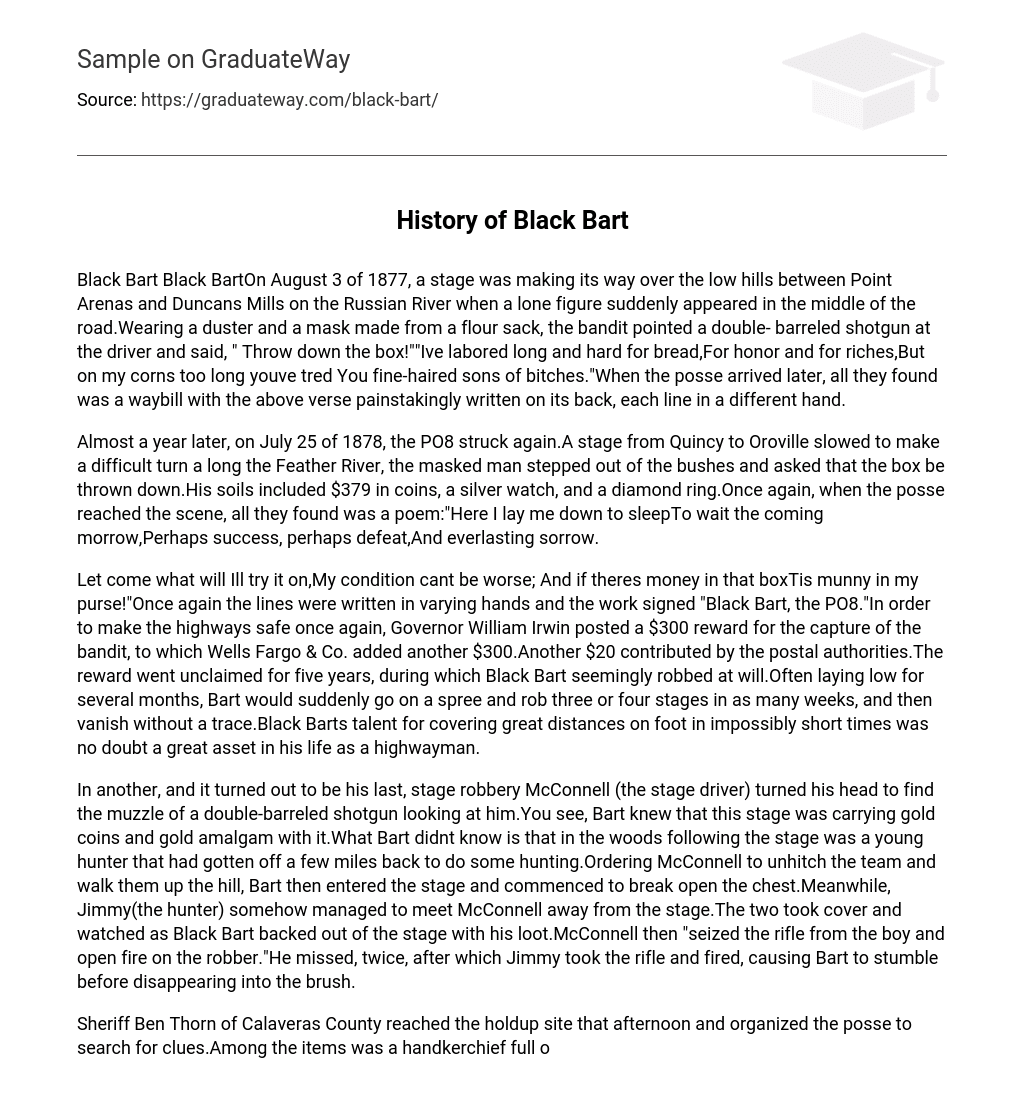On August 3, 1877, a stagecoach journeyed from Point Arenas to Duncans Mills on the Russian River. Along the way, an individual wearing a duster and a mask made of a flour sack suddenly emerged in the middle of the road. Holding a double-barreled shotgun towards the driver, this person demanded that they “Throw down the box!” Additionally, the bandit delivered a poem expressing their hard work for necessities and desire for wealth while feeling mistreated by those perceived as privileged. Later on, when a posse arrived at the scene, they found a waybill with the aforementioned poem written on its back; each line was penned by different individuals.
Around one year later, precisely on July 25, 1878, the PO8 gang committed another offense. This time, their target was a stagecoach en route from Quincy to Oroville. When the stagecoach decelerated to negotiate a challenging turn along the Feather River, an individual wearing a mask emerged from the bushes and demanded surrender of the box. Inside this container were various valuable items such as $379 in coins, a silver watch, and a diamond ring. Consistent with their usual approach, upon arrival at the crime scene, all that was found by the posse was a poem left behind by the criminals. The poem went as follows: “Here I lay me down to sleep,
To wait the coming morrow.
Perhaps success, perhaps defeat,
And everlasting sorrow.”
Let whatever may come, I will try it on. My situation cannot be worse; And if there is money in that box, it is money in my purse!” Once again, the lines were written by different people and the work was signed “Black Bart, the PO8.” To restore safety to the highways, Governor William Irwin offered a $300 reward for the capture of the bandit, with an additional $300 donated by Wells Fargo & Co. Yet another $20 was contributed by the postal authorities. Despite this, the reward remained unclaimed for five years, during which Black Bart seemed to be robbing at his own leisure.
Bart would often remain hidden for months before suddenly embarking on a series of stagecoach robberies in rapid succession. His ability to cover great distances on foot in extremely short periods was undoubtedly a valuable skill for his life as a highwayman.
In his final stage robbery, McConnell, the stage driver, glanced and saw a double-barreled shotgun aimed at him. Bart was aware that this particular stage was transporting gold coins and gold amalgam. However, he was unaware that a young hunter had disembarked several miles earlier to engage in some hunting, and was now following the stage in the woods.
McConnell was ordered by Bart to release the team and guide them up the hill. Bart then proceeded to enter the stage and start opening the chest. At the same time, McConnell and Jimmy (the hunter) were somehow able to meet away from the stage. The two sought cover and observed as Black Bart emerged from the stage with his stolen goods. McConnell then took control of the rifle from Jimmy and attempted to shoot at the robber. He missed twice, after which Jimmy took the rifle and fired, causing Bart to stumble before vanishing into the undergrowth.
Sheriff Ben Thorn of Calaveras County arrived at the holdup location in the afternoon and coordinated a search party to investigate for evidence. One of the items discovered was a handkerchief filled with buckshot, which would ultimately prove to be his undoing. In one corner of the handkerchief, there were some small letters: F.X.O.7., revealing it to be a laundry identification number.
Sheriff Thorn brought the evidence to San Francisco detective J. B. Hume at Wells Fargo.
Hume then handed the handkerchief to special operative Harry Morse, who promptly began tracking the laundry mark.
After a week, on November 12, the laundry was located, and the owner of the handkerchief, Charles E. Bolton, was identified.
Bart was arrested and, following extensive questioning, chose to confess to the robbery.
He also agreed to reveal where he had hidden the amalgam in hopes of facilitating his trial process.
Upon the recovery of the amalgam, Bart appeared before Superior Court Judge C.V. Gottschalk at San Andreas on November 17. Throughout his career as a highwayman, Black Bart successfully robbed twenty-eight stages. However, upon his capture, he only confessed to his most recent theft and was subsequently sentenced solely based on that incident. As a result, he was given a six-year imprisonment term at San Quentin Prison.
Charles E. Bolton, an American Indian, vanished without a trace shortly after his release from prison on January 21, 1888.





